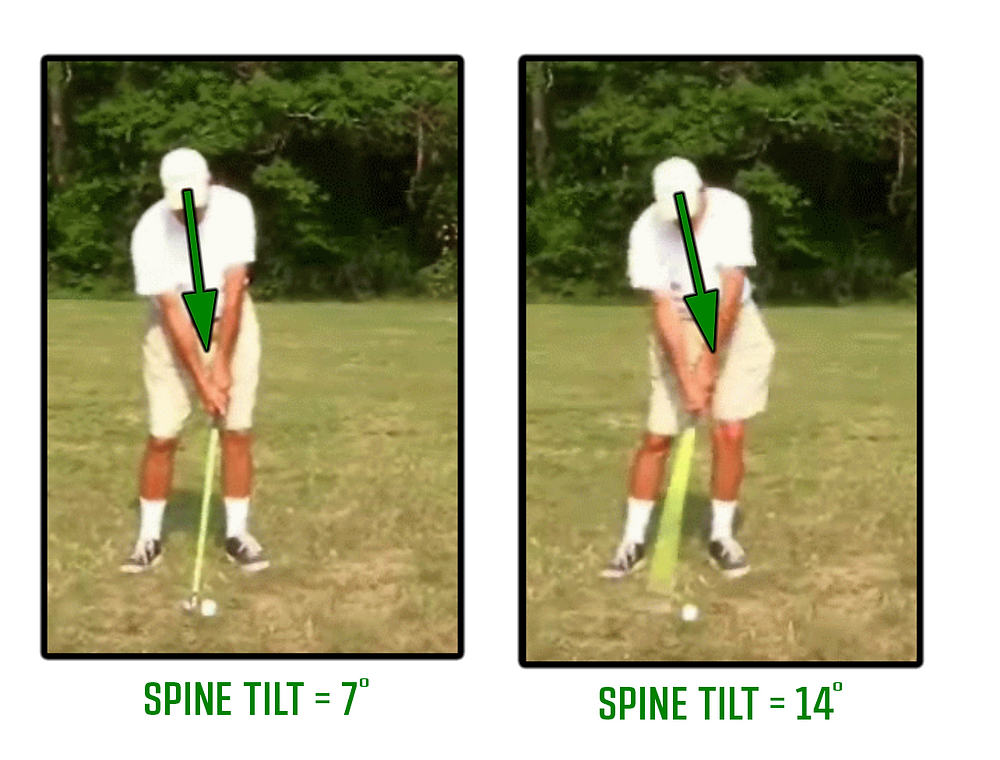Why Frontal Spine Angle Must Increase
Somax Sports has on their web site a number of articles implying that the frontal golf spine angle at impact should be as close as possible to the frontal spine angle at address. Among their assertions:
-
Hank Haney taught Tiger to increase his frontal spine angle more than before, and that is the reason Tiger had to learn to yell, “Fore, right!”
-
Ben Hogan never actually used as much frontal spine angle as shown in the famous picture in his “Five Lessons” book.
I buy the notion that there is such a thing as too much increase in frontal spine angle. But… The frontal golf spine angle must increase in a proper swing. Cutting the increase too much is even worse than leaving a large increase. Here’s the reasoning.

The pair of pictures above is of my own swing, one at address and the other at impact. I have twice as much frontal spine tilt at impact as I do at address (14º vs 7º). I absolutely need it in order to make a proper swing. The reasoning is a few basic principles, followed by very basic physics and geometry.
Here are a few basic principles of a good swing. Violate them, and evil things happen.
-
The head should not move forward in the downswing; it should be in the same lateral position at impact as it was at address.
-
The feet should be in the same position at impact as they were at address. (This is essential, whether or not you lift your heel at the top of the backswing. If you do, you want the heel to come back down where it was before.)
-
The weight should be primarily on the forward leg (left leg for a right-handed golfer) at impact.
Is that all happening in my swing as pictured?
-
You can verify from the foliage in the background that my head is very close to the same place. There is an inch or two of forward motion.
-
The feet are in the same place. (I don’t even lift my heel in the backswing.)
-
Visually, my weight is about centered at address, but it certainly looks like it has shifted to the front foot at impact. And indeed it has. (Side note: At address, my weight is more or less evenly distributed between my feet. That would not be true for stack’n’tilt — and the reasoning about increasing golf spine angle would not hold for stack’n’tilt. If you are already a stack’n’tilter, this does not apply to you.)
How is it even physically possible for the weight to shift forward, if the feet and head are stationary? The only way that can happen is for the middle of the body to move forward. If you look at the background, you will see that everything from my knee to my belt has moved forward substantially. The only way to move the weight forward, with the top and bottom held fixed, is for the middle to move forward. That’s simple physics.
So what happens if the middle (belt, hips, thighs, knees) move forward while the head and neck remain where they were? The spine tilt increases! It’s just geometry.
Let’s look at the negative of this proposition. If Somax is saying that the goal is zero increase in spine tilt, that can only be accomplished if there is no weight shift at all, or if the head lunges forward as much as the rest of the weight. Neither of these is conducive to a good swing. So I must conclude that an increase in spine tilt is good and necessary — even if there is perhaps an amount that it should not exceed.
For the second spine angle, imagine a vertical line extending upward and starting at the base of the golfer’s spine. Now imagine a second straight line from the base of the golfer’s spine, extending up and through the center of the golfer’s head. For most RH golfers with the proper address, the head and therefore the spine are tilted slightly to the right. This angle may best be referred to as the frontal spine angle.
Fix Your Swing Today With The Pro-Head 2 Golf Swing Trainer!


